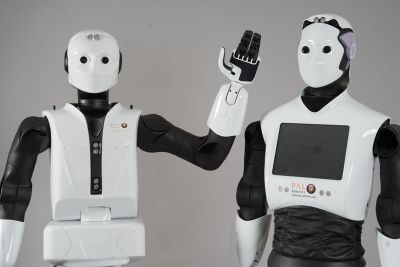Robots take over the ironing

Robots, fot. By JosepPAL (Own work) [CC BY-SA 3.0
EU-funded researchers have developed a robot capable of sorting through and folding piles of rumpled clothes.
Advancements in robotics have enabled humankind to automate a whole
range of industrial processes, leading to more efficient and safer
production and helping to expand our knowledge through scientific
discovery. Why is it, however, that we can send a robot into space to
take samples of Martian rocks, but still can’t delegate the ironing to a
household robot?
The recently completed EU-funded CLOPEMA project may finally have a
solution to this problem. A robot has been developed that in tests has
been shown to be capable of organising ‘deformed’ fabrics (i.e. sorting
through a pile of crumpled clothes), and then folding each item neatly.
What makes this process so complex is that clothes, unlike objects
usually manipulated by robots, do not retain their shape. A new way of
receiving and processing information was required.
One of the novel challenges of this project has been designing the
clothes folding prototype robot from (mainly) off-the-shelf components.
A variety of components have been assembled – such as cameras and a
range of other complex sensors – and integrated into one operating
system. A special built-in camera for example enables the robot to see
the fibres up close, and to differentiate light fabrics from dark and
starchy materials from more flexible ones.
In tests, various garments were presented in a random pile on an
arbitrary background, and random requests made sorting, folding, etc.).
With a mechanical arm, the robot chooses a random fabric, which it then
folds and places neatly on a surface. Results were measured and analysed
within three carefully defined demonstrator projects of increasing
difficulty.
In order to provide help the robot perceive and manipulate garments
in 3D through an active binocular robotic vision system, a database of
80 colour images with corresponding horizontal and vertical disparity
maps was created. This database is based on 16 different off-the-shelve
garments. Each garment was imaged in five different pose configurations
on the project's binocular robot head.
The end result is a state of the art robot capable of autonomously
perceiving and manipulating all kinds of fabrics, textiles and garments.
The operating-software is based on ROS (Robot Operating System) and
written in C++, Python and Java.
So is this the future of ironing? A commercialised domestic ironing
robot may still be some way off. Human hands are highly complex; certain
subtle movements such as unbuttoning a shirt are still challenging
tasks for robots to perform.
The most likely practical use for this prototype robot might be in
sorting through fabrics in an industrial setting, with human assistance.
The project team has already made contact with a clothing manufacturing
company in Italy to investigate the possibility of commercially
exploiting robots in the manufacturing sector.
published: 2015-04-03